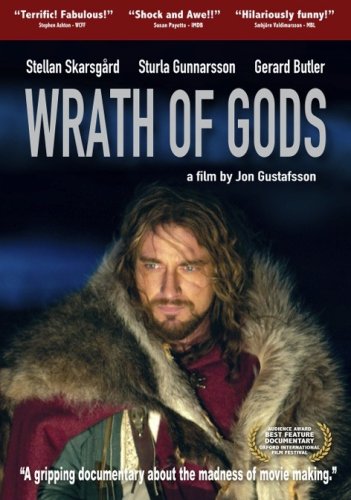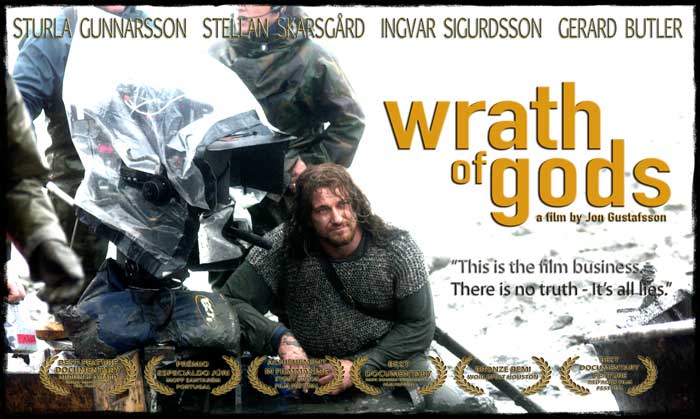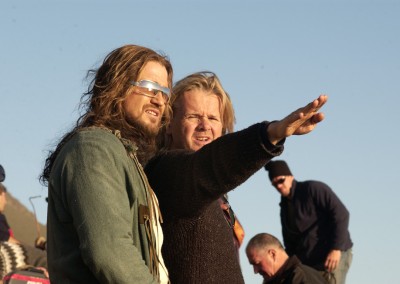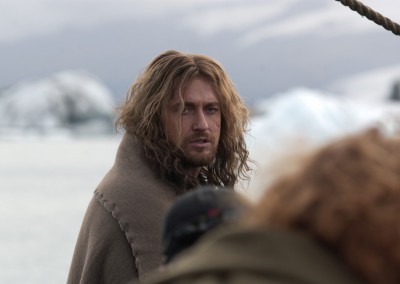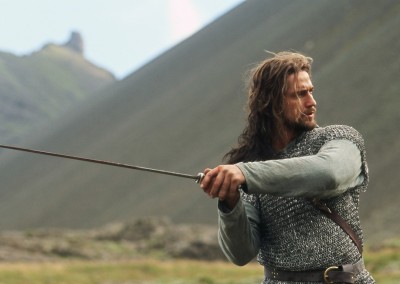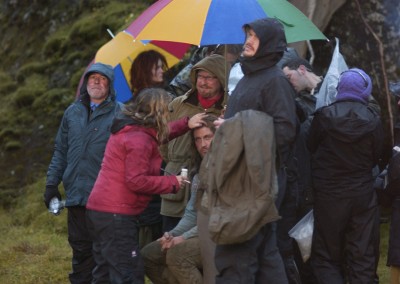Gerard Butler in WRATH OF GODS
A DOCUMENTARY ABOUT FILMMAKING IN EXTREME CONDITIONS BUY THE DVDWATCH ONLINEWhen Canadian director Sturla Gunnarsson and his cast and crew, including Gerard Butler (300, Phantom of the Opera, How To Train Your Dragon) set upon Iceland to film Beowulf & Grendel, they expected the usual complications involved in making a movie, but what they encountered made them wonder if the Norse gods were actually working against them. Award-winning documentary Wrath of Gods by Jon E Gustafsson tells this amazing story of the extremes that independent filmmakers go to in order to make their movies.
THIS IS THE MOVIE BUSINESS
Produced in association with CBC NEWSWORLD
supported by THE ICELANDIC FILM CENTRE
produced by GREAT CANADIAN FILM FACTORY and ARTIO FILMS
produced by JON GUSTAFSSON, KAROLINA LEWICKA
written and directed by JON GUSTAFSSON
co-produced by JON ARMANN STEINSSON and GERARD BUTLER
music by HILMAR ÖRN HILMARSSON
The storms tore roofs of buildings and swept away equipment, and Gunnarsson slowly seemed to take on the characteristics and physical appearance of a troll as he struggled to fight gigantic obstacles. The strong determination of the filmmakers (Sarah Polley called it a “sheer demented ambition”) was the one thing that seemed to be able to steer this troubled ship through the storms and guide it to harbour. Two days before the end of principal photography Producer Paul Stephens admitted that is was a “miracle” that they were about to complete the shoot without having closed the ‘bank’. To most other people on the crew it was a miracle that no one had died in a series of accidents and other unfortunate events that haunted the production.
Everyone became superstitious in Iceland. How could they not? They went through just about everything that you can imagine would happen on a film production. Two weeks before the start of principal photography, the financing had not closed and the production was unable to meet its payroll. The crew was called in and told that the production was on the brink of collapse. The crew was asked to take a week’s hiatus without pay while the producers tried to resolve the crisis. Close to two million dollars had been spent already, but at this point they were looking at shutting the production down. Sturla gave the “over my dead body” speech. The following week they managed to fix the cash flow situation temporarily, but once again the shoot had to be postponed by a couple of weeks. By now they were starting five weeks later than they had hoped. The unforgiving Icelandic winter was approaching fast.
After moving the whole company to the town of Hofn on the east coast of Iceland, the production was sent off with a Pagan blessing, performed by Hilmar Orn Hilmarsson, a composer and the high priest of the ancient Norse Asatru religion. There he called upon Odin, Thor and Baldur to protect the production. Right at the end of the ceremony Sturla fell and hit his head on the rocky beach. His Icelandic co-workers eagerly shared the old Icelandic superstition that falling at the start made for a prosperous journey. Two hours later the Pagan priest himself slipped on the rocks at the Hofn beach and broke three ribs. The story of Beowulf & Grendel includes the introduction of Christianity into a Pagan society and the inevitable struggle between the two religions. That Saturday night, some of the producers started wondering if the Pagan ritual had angered the wrong god. Gerard Butler and the rest of the cast and crew started joking about the “curse” but as time went on the jokes gained a more serious undertone.
Getting a Viking boat replica to use in the film had proven to be extremely difficult and expensive, but sailing a Viking boat through an iceberg passage was one of the scenes that had Gunnarsson refused to give up. Only one of those boats exists in Iceland and even if it had been sailed across the North Atlantic to celebrate the Millennium, it had been in a museum for a couple of years and was drying up. The owners wouldn’t do any work on the ship till they had a guaranteed payment from the film producers, so the ship wasn’t transported to the filming location till the eleventh hour. Once it made it to the Iceberg Lagoon and was lowered into the water, it leaked so badly that it would have sunk in minutes. It had to be taken out of the water again and repaired. The film crew got ready for their only chance of filming a Viking boat sailing in between the icebergs.
On Sunday night, a passenger van carrying members of the crew on their way to the filming location had a head-on collision with an SUV on the longest single lane bridge in Iceland. Both vehicles were totalled, but for some unbelievable luck no one was seriously injured. That same night the crew received word that the Viking boat would actually be able to float, or at least appear to float when they were to start filming six hours later. The captain had managed to make the boat float by installing two industrial strength pumps, and they could not be turned off for more than a minute, or the boat would sink. The life expectancy in the Iceberg Lagoon is around 3 minutes, perhaps 4 if you keep your head above water and your arms close to your body. The notion that everyone was at the mercy of the elements and higher powers was evident from that first day of the shoot.
